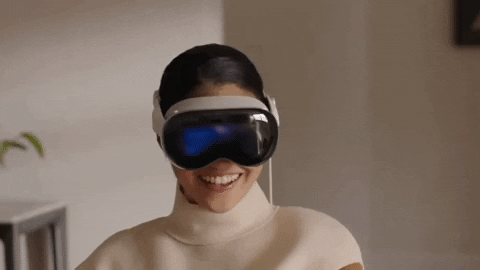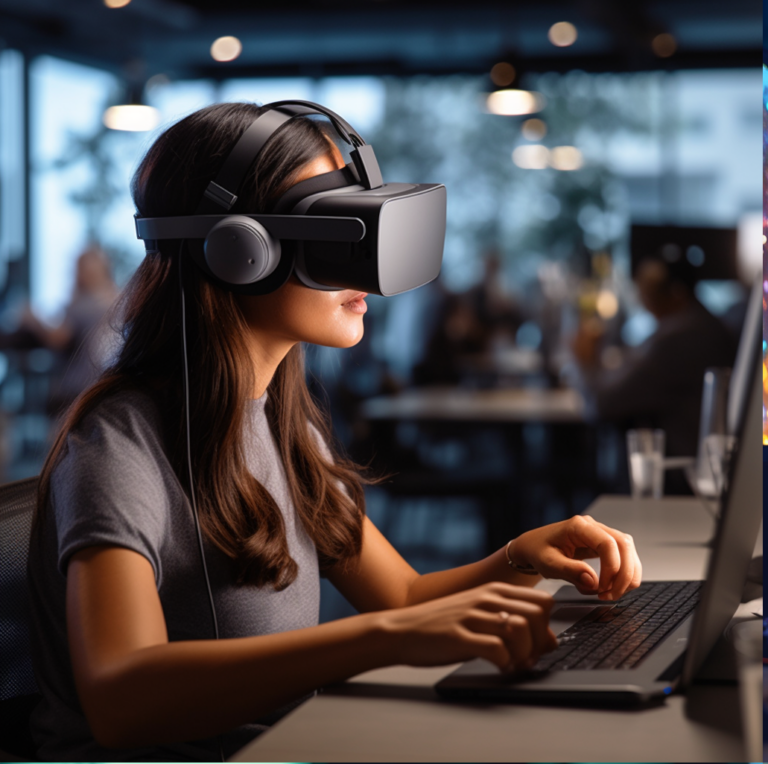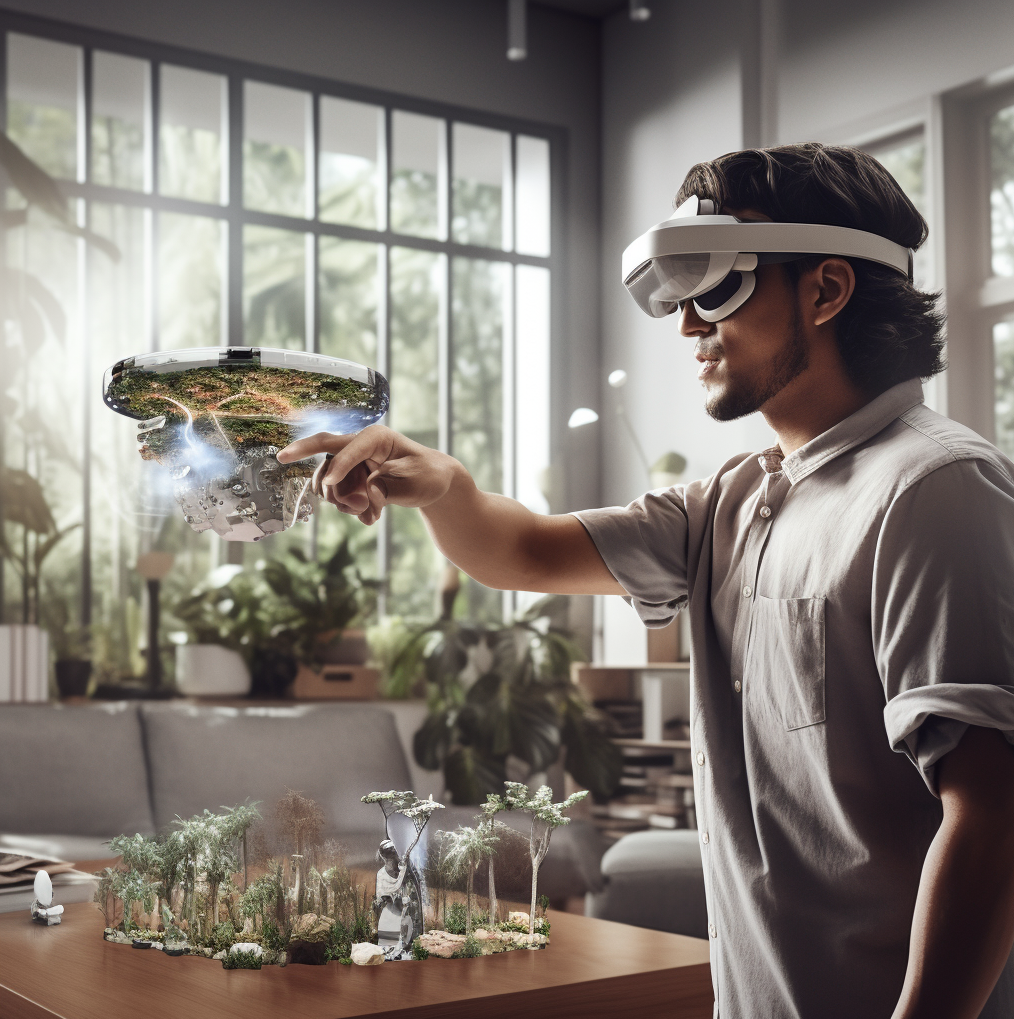At the annual Worldwide Developers Conference (WWDC) on June 5, Apple unveiled its groundbreaking augmented reality/virtual reality (AR/VR) headset, the Apple Vision Pro. This release marks a significant shift in the company’s consumer electronics range, with the gadget being marketed as a “spatial computer” rather than just a headset. Packed with cutting-edge features, including a 3D camera, spatial audio, and an array of sensors and cameras, the Vision Pro aims to redefine how we engage with the digital world by blurring the boundaries between reality and virtual experiences.
The Apple Vision Pro is equipped with a 4K display screen for each eye, enabling users to immerse themselves in a stunning visual environment. Its advanced capabilities allow users to interact with floating menus in their real-world surroundings, whether it’s their living room, office, or any other location. Voice commands, delicate hand gestures, and eye motions will serve as the primary means of operating the device and its applications.
While Apple announced it as an AR headset, there have been questions about whether it truly falls into the AR or VR category
IT’S A VR HEADSET….
The Apple Vision Pro is, indeed, a VR headset. It features an opaque heads-up display that completely covers the user’s vision, aligning with the traditional definition of VR rather than AR.
Promotional materials showcase the Apple Vision Pro being used with projected apps in physical spaces, and the EyeSight feature allows the display to be transparent to people around the user. However, for the user wearing the headset, the view remains entirely determined by the OLED screens, and transparency is not achieved.
…THAT ACTS LIKE AN AR HEADSET
Nevertheless, the Vision Pro excels in its ability to incorporate AR functionality. Spatial computing lies at the core of its design, utilizing the surrounding physical environment to create a visual representation within the headset. This enables the device to overlay its own user interface, apps, and content onto the real-world environment. Users can experience virtual screens throughout their field of view, virtually utilizing multiple monitors alongside their physical keyboard and mouse. Furthermore, 3D objects can be seamlessly integrated into the user’s real-world desk.
At the same time, the Vision Pro can fully immerse users in a virtual environment, whether it’s an application, game, or movie. This capability aligns with the concept of VR. Despite this, the majority of Apple’s launch video emphasized the AR aspects of the Vision Pro, showcasing its potential in augmenting our surroundings.
Exploring the Potential of Apple Vision Pro in Gaming
- Immersive Gaming Experiences
The Apple Vision Pro’s impressive features, including high-resolution displays and advanced spatial audio, have the potential to transport players into captivating virtual worlds. The device’s intuitive controls, tracking head movements and hand gestures, can enhance the sense of immersion and interactivity in gaming. The spatial computing capabilities can also facilitate the creation of unique gaming environments that seamlessly merge with the real world, providing a novel gaming experience.
- A Focus on the Workplace
During its unveiling at WWDC, the Vision Pro was primarily positioned as a tool for the workplace, emphasizing productivity, collaboration, and creativity. Its spatial computing features, such as virtual screens and 3D object integration, hold immense potential for professionals in various industries. While gaming was not the primary focus, the versatility of the device suggests that it could adapt to accommodate gaming experiences in the future.
- Future Possibilities
As the AR/VR industry progresses, it is likely that developers will leverage the Vision Pro’s capabilities to create tailored gaming content for the headset. While the initial focus is on transforming the workplace, the device’s potential for immersive gaming experiences should not be overlooked. With Apple’s commitment to user experience and innovation, the Vision Pro could evolve to cater to the demands of the gaming community, opening up new horizons for immersive gameplay, virtual reality storytelling, and competitive eSports experiences.

Future of gaming at Apple
What factors could motivate Apple to prioritize gaming as a key feature of Vision Pro? The potential for top-tier Vision Pro applications to resemble enhanced versions of current augmented reality (AR) experiences suggests that Apple has been actively encouraging AR app development for some time. It is conceivable that we could witness experiences on the scale of Pokémon Go, but in a more immersive and larger context. Additionally, envisioning advancements in immersive viewing experiences with Vision Pro is not difficult, as Apple has already demonstrated improved sports viewing capabilities, such as live display of various information alongside a game.
It is important to note that Vision Pro, especially with Apple’s “see-through” lens design, primarily offers a single-player experience. Analysts have observed that Meta’s Quest, which lacks see-through lenses and embraces a more digitally immersive design, may be better suited for longer periods of gameplay and interaction with online communities in social games like VRChat. This does not imply that Apple is inferior in any way, but rather suggests that developers might require more time to explore the gaming potential of Vision Pro.
Meanwhile, Meta and Sony are likely to maintain their dominance in the XR/VR gaming landscape due to their substantial investments in the field and their intention to target both dedicated gamers and mass-market consumers who can afford a device priced under $1,000 more easily.
Apple has a remarkable history of successfully launching new devices, and Vision Pro is clearly positioned to become the most advanced XR device available. Although gaming did not play a central role in the product’s announcement, it is difficult to believe that game developers will not eventually flock to the device in large numbers. The timing, success, and depth of the titles they release remain uncertain, but if executed properly, we may be on the brink of a new era in gaming exploration within the realm of XR.

How is Apple Vision Pro using AI?
• Apple Vision Pro introduces the capability for users to generate a digital avatar, enabling more realistic video interactions.
• To accurately depict facial and hand movements during FaceTime conversations, Apple employs “advanced machine learning,” a form of artificial intelligence (AI).
• Videoconferencing proved to be one of the “most challenging obstacles” for the team, as users were wearing eyewear that obscured their faces.




